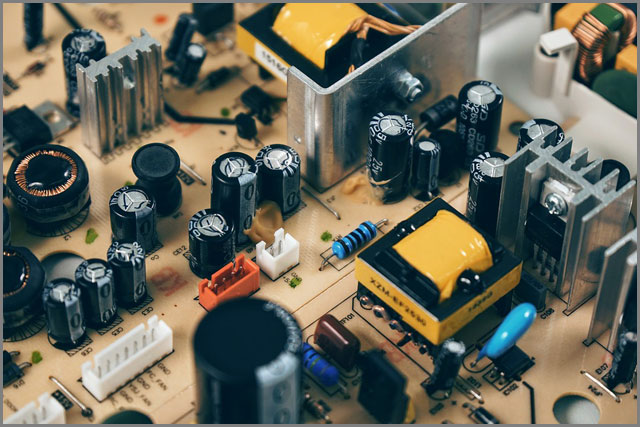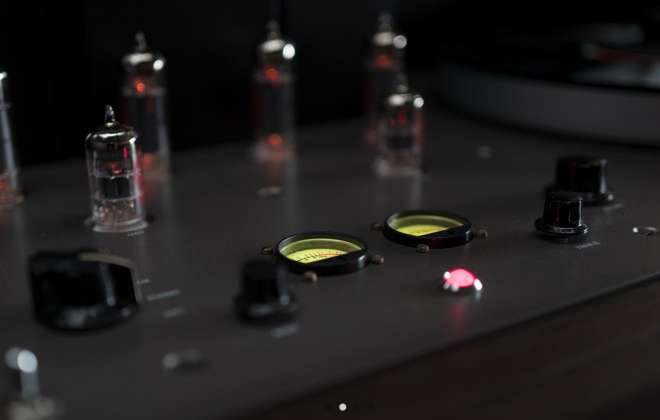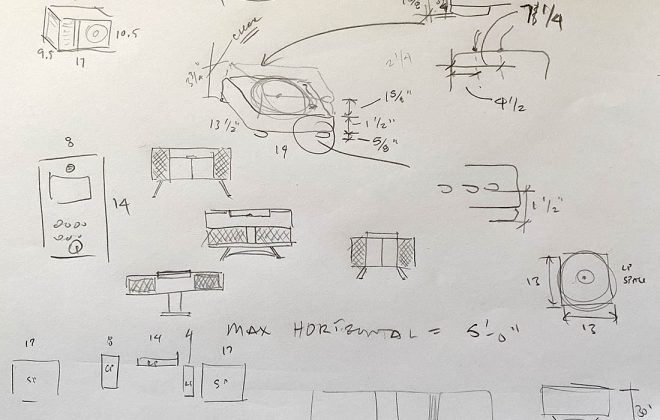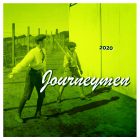Console: No Guts, No Glory
If you’ve been reading along, you’ll know that I’ve started the process of building my own music console. Each of the installments should stand on its own but if you wanted to start at the beginning, here it is.
As Louis Henry Sullivan wrote, form (ever) follows function. Or, in modern vernacular, the design of an object should match its purpose.
We’ve established that at its very core, my music console will play music. Regardless of how this gets dressed up in speaker fabric, walnut veneer, or hinged panels, the purpose won’t be met unless the music-making components function—they produce sound.
As such, let’s start with the guts of the system. The form of the final piece should contain these guts in a way that maximizes sound quality, utility, and aesthetics.
Function
We’ve established that it should play records, play digital audio files, and perhaps even have a radio. For convenience and future proofing, it should have a bluetooth receiver, and aux in.
The heart of any audio system will be the speakers and an amplifier. In addition to direct listening, I’d also like to have a headphone jack.
The easiest way to achieve this is to purchase an off-the-shelf unit that has all these components built-in and just build a frame around it. Or put it into an empty console shell.
The advantage with this approach is that as technology advances, you simply swap out the innards and replace it with a new unit. It’s the approach we’ve taken in our living and dining rooms where we’re using built-in bookcases as standalone stereos.
You’d still need a separate record player (we don’t have one in either our living or dining rooms) and it would feel like you pieced it together—it wouldn’t feel like a single-function piece of furniture.
As you probably guessed, I’m going for the more complicated solution. What parts are we going to need?
The Master List
We’ve established the inputs and outputs. What does that look like schematically?
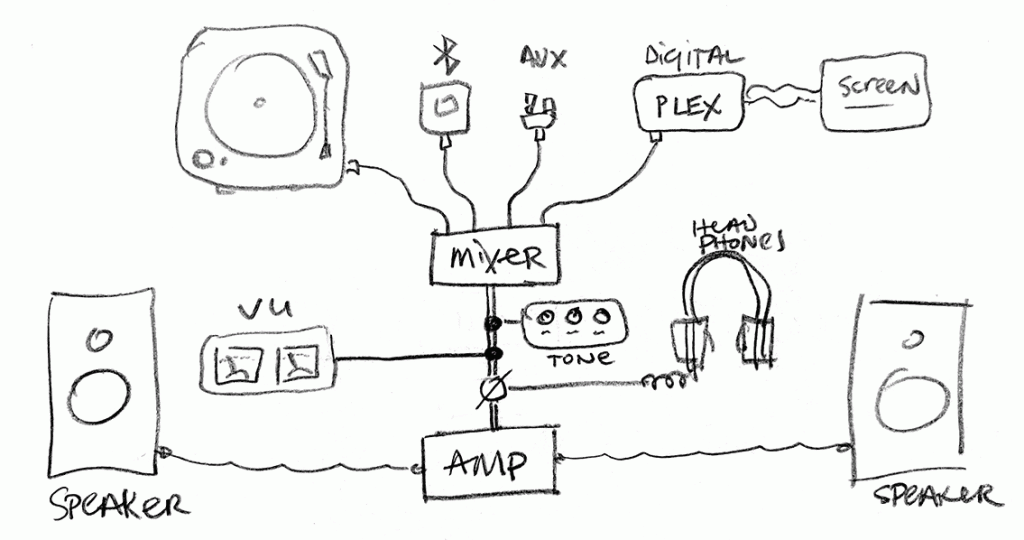
Or in list form:
- Speakers
- Amplifier
- Tone Control
- VU Meters
- Digital File Playback
- Headphone Jack
- Turntable
- Mixer
- AUX in Jack
- Bluetooth Receiver
- Radio Receiver (optional, not shown)
I’ll get into each of these areas in detail, but for starters, here’s a high-level overview.
Speakers
There are 3 basic options here: self-powered (no amp needed) standalone, passive standalone, or integrated.
The way these were built in the 60s and 70s, the speaker boxes were the furniture. Manufacturers would cut holes in the front and/or sides of the large console box and mount speaker cones. Higher-end models probably had insulation, baffling, and isolation panels. Lower-end models had a full-range speaker cone attached to the front. Integrated is how a purist would proceed.
However, I’m not a purist. I have nothing against putting existing speakers into a second box. It gives me a chance to further isolate their vibrations from the record player and means this won’t turn into a custom speaker design project. I’m decidedly NOT an audio engineer.
Amplifier
If it isn’t built into the speakers, then I’ll need to have an amplifier to power the speakers.
I have a couple of old integrated amps lying around that I upgraded from. I could straight up install one of these as the primary interface for the system. But that would be ugly. And I’d have to deal with temperature regulation. And it would be totally overpowered.
Other options include buying an amplifier circuit board, buying a small power amp, buying a car amp, or finding an old analog integrated amp on ebay with a radio tuner—thusly killing two birds with one stone.
I’ll probably end up with a small power amp, but more on that later.
Tone Control
If this is built into an integrated amp, then it’s going to be unnecessary as a stand-alone component. But if I’m going to be using a power amp, most don’t have the ability to boost or attenuate bass or treble.
It could take form as a graphic equalizer or a tone shaping pre-amp card.
I’ll probably end up with the card, but an equalizer is attractive since tone tends to be a “set it and forget it” thing for me.
VU Meters
Ok, these are totally unnecessary. But they’re cool and they provide some feedback on the audio signal in the system… so I totally want them.
The only options here are whether or not to install them.
Digital File Playback
There may be a lot of options here, but since I’m running a PLEX server in my house, my selection is pretty clear.
I will be using a raspberry pi outfitted with a special D/A conversion hat integrated into the system. Of course, this means I’m going to need to have certain inputs and outputs to support this setup. More about that later.
AUX In / Headphones
These might be part of the power amplifier. If they’re not, it makes things a lot more complicated. I’ll probably try and find a power amp that includes both.
Turntable
There are a bazillion options here and it’s all personal preference. You can go crazy and build in pro level dj table, a high-end audiophile model, a good mid range model, or an inexpensive “good-enough” model. You want to stay away from cheap models that could ruin your vinyl.
I chose the inexpensive good-enough model because I’m trying not to spend a ton on this project. Frankly, I’ve been surprised at how good it sounds.
Mixer/Audio Source Switch
Technically, this could be either a switch or a mixer.
If I get a switch, you would have to manually select your audio source each time you played something. Say you were listening to digital but wanted to hear a record—rotate the switch to the record setting. While this is quaint and adds a hint of old-school analog to the system, it’s technically unnecessary. But it might be desirable.
I could get an active or passive mixer that would permanently mix together all my sources at once. I have a passive mixer in our dining room that combines the source for our whole house audio feed with a framed iPad running PLEX and an Echo Dot and I won’t go back. Switches are for chumps.
Unless… one of your sources is either always feeding in audio (like a radio) or has a high noise floor. Undoubtedly a switch should be cleaner unless it suffers from signal bleed.
The choice probably comes down to selecting between convenience and sound quality.
Also, a mixer is easier to use—a switch requires careful soldering.
Bluetooth Receiver
I have one of these that I don’t love in service in my study. It’s pretty aggressive in connecting to anything in range that it remembers which is kind of annoying.
Also, it has a physical button for pairing that I’d need to expose somehow. And it’s ugly.
The optimal receiver will adhere to the current standards (BT 5.0+) and support both APT-X and AAC streaming at a minimum.
Practically, I’m only going to be using this for ad-hoc listening from my phone or laptop. Since both of those are currently Apple devices, I shouldn’t expect very high quality when using bluetooth.
Radio Receiver
While I would like one of these, I’m finding it hard to source at a reasonable price.
My parents had one that was the right size as part of their stereo setup in the ’80s but it’s long gone.
Most of the ones I find on ebay tend to be too big or integrated into amplifiers.
And if I’m being 100% honest with myself, I NEVER listen to broadcast radio.
The Kitchen Sink
Anything else I should add?
I considered a CD player, but I haven’t turned on any of those in my house in over a year. Maybe longer.
Cassette player? I thought about it. I have an extra deck that needs new belts, but I never listen to cassettes anymore. Also, it would take up a lot of room.
8 Track or Reel to Reel? I have maybe two reels and I gave all my 8 tracks to my dad who still has a player in his workshop. Not worth the hassle.
That should about cover it. Let’s dig into some of the individual component choices next.
